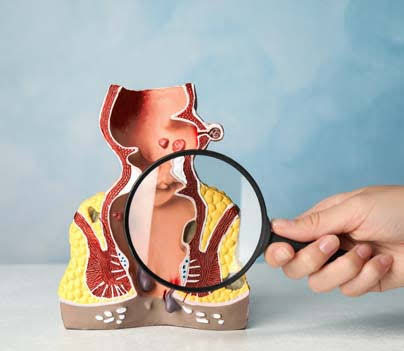fistula
An anal fistula – also called fistula-in-ano – is a tunnel that develops between the inside of the anus and the outside skin around the anus. The anus is the muscular opening at the end of the digestive tract where stool exits the body.
Most anal fistulas are the result of an infection that starts in an anal gland. The infection causes an abscess that drains on its own or is drained surgically through the skin next to the anus. This drainage tunnel remains open and connects the infected anal gland or the anal canal to a hole in the outside skin around the anus.
Surgery is usually needed to treat an anal fistula. Sometimes nonsurgical treatments may be an option.

Symptoms
Symptoms of an anal fistula can include:
- An opening on the skin around the anus
- A red, inflamed area around the tunnel opening
- Oozing of pus, blood or stool from the tunnel opening
- Pain in the rectum and anus, especially when sitting or passing stool
- Fever
Causes
Most anal fistulas are caused by an infection that starts in an anal gland. The infection results in an abscess that drains on its own or is drained surgically through the skin next to the anus. A fistula is the tunnel that forms under the skin along this drainage tract. The tunnel connects the anal gland or anal canal to a hole in the outside skin around the anus.
Rings of sphincter muscle at the opening of the anus allow you to control the release of stool. Fistulas are classified by their involvement of these sphincter muscles. This classification helps the surgeon determine treatment options.
Risk factors
Risk factors for an anal fistula include:
- Previously drained anal abscess
- Crohn’s disease or other inflammatory bowel disease
- Trauma to the anal area
- Infections of the anal area
- Surgery or radiation for treatment of anal cancer
Anal fistulas occur most often in adults around the age of 40 but may occur in younger people, especially if there is a history of Crohn’s disease. Anal fistulas occur more often in males than in females.
Complications
Even with effective treatment of an anal fistula, recurrence of an abscess and an anal fistula is possible. Surgical treatment may result in the inability to hold in stool (fecal incontinence).
Diagnosis
To diagnose an anal fistula, your health care provider will discuss your symptoms and do a physical exam. The exam includes looking at the area around and inside your anus.
The external opening of an anal fistula is usually easily seen on the skin around the anus. Finding the fistula’s internal opening inside the anal canal is more complicated. Knowing the complete path of an anal fistula is important for effective treatment.
One or more of the following imaging tests may be used to identify the fistula tunnel:
- MRI can map the fistula tunnel and provide detailed images of the sphincter muscle and other structures of the pelvic floor.
- Endoscopic ultrasound, which uses high-frequency sound waves, can identify the fistula, the sphincter muscles and surrounding tissues.
- Fistulography is an X-ray of the fistula that uses an injected contrast to identify the anal fistula tunnel.
- Examination under anesthesia. A colon and rectal surgeon may recommend anesthesia during an examination of the fistula. This allows for a thorough look at the fistula tunnel and can identify any possible complications.
Other options to identify the fistula’s internal opening include:
- Fistula probe. An instrument specially designed to be inserted through a fistula is used to identify the fistula tunnel.
- Anoscope. A small endoscope is used to view the anal canal.
- Flexible sigmoidoscopy or colonoscopy. These procedures use an endoscope to examine the large intestine (colon). Sigmoidoscopy can evaluate the lower part of the colon (sigmoid colon). Colonoscopy, which examines the full length of the colon, is important to look for other disorders, especially if ulcerative colitis or Crohn’s disease is suspected.
- An injected dye solution. This may help locate the fistula opening.
